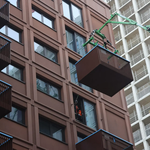mdrejhon
Senior Member
This be true. What is TTC's long term plan for trolleypole compatibility?Not a problem. Overheads which are pantograph ready also cope quite well with trolley poles. The section from Bathurst along Fleet Street through the streetcar track within the CNE grounds was, and continues to be used by both the pantograph equipped 509 cars and the pole equipped 511 cars. Summary - both pantograph and pole equipped cars can use overheads which have been upgraded for pantograph operations, but only pole equipped cars can use overheads which have not yet been upgraded.
Now that CLRVs are being added to the TTC museum fleet, it does beg the question: Will the catenary remain compatible in 50 years from now?
There are changes to catenary that can reduce future trolleypole compatibility. Depending on what is eventually installed overhead over the years. Little things like, catenary is often intentionally wavier (side to side) for pantograph operation to allow even wear and tear along the top of the pantograph. TTC may do this later once all the CLRVs are retired. This might lead to trolleypole instabilities at full speed operation, though it probably doesn't matter at lower speeds of a "museum run" -- trolleypoles will deal with that at low speeds, like turning a curve where the catenary has sharp angles.. And the diameter of pantograph wire can later become thicker to allow more electric current to travel over it, without needing new pantographs. I wonder if that will cause issues. And there are pantograph devices at intersections in other cities that are pantograph-only and incompatible with trolleypole. Over time, there are pantograph-catenary optimizations that may reduce trolleypole reliability or even compatibility. When the fleet is 100% pantograph except for the museum fleet, it might be costly to permanently remain fully trolleypole compatible in future catenary rebuilds.
For museum fleet deployments -- I presume there are simple solutions -- like replacement contact-shoes for trolleypoles for wire-diameter changes -- and reduced speed operations to deal with less straight wires on straightaways.
Happy 100th anniversary TTC Little Peter Witt #2766 in year 2023! It shall must make a number of mandatory in-service runs to celebrate the centenary. I hope to tap my Presto card on that Peter Witt sometime.
Last edited:




